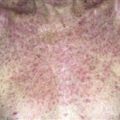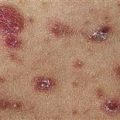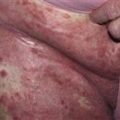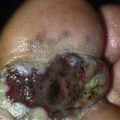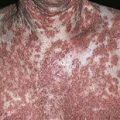109
Polymorphous light
eruption
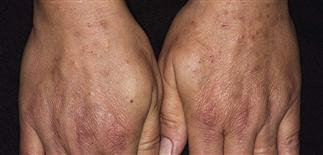
The papular type is the most common form. Small papules are densely aggregated. The back of the hands is the most common site.
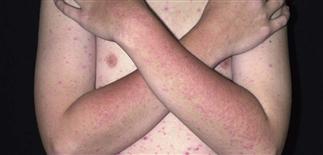
Small papules are disseminated or densely aggregated on a patchy erythema.
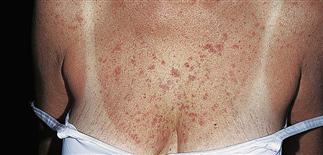
The papulovesicular type begins with urticarial plaques from which groups of vesicles arise.
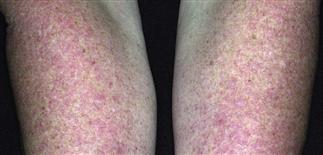
The papulovesicular type occurs primarily on the arms, the lower limbs, and the ‘V’ area of the chest.
DESCRIPTION
Idiopathic, recurrent photodermatitis that comes on acutely, usually in spring with first prolonged sun exposure.
HISTORY
• Commonly referred to as sun poisoning or sun allergy. • Occurs in all races, at any age, but most common in young women, in whom the incidence is as high as 10%. • Occurs in northern climates where sun intensity increases in spring, and during winter vacations while visiting southern, sunny resorts. • Symptoms may include pruritus, malaise, chills, headache, nausea. • Usually appears with first one or two exposures to sunlight in spring. Ultraviolet A is trigger in most cases, although the amount of exposure needed to trigger a flare varies. • Hereditary polymorphous light eruption occurs in Inuit and Native American people. • Autosomal dominant transmission with incomplete penetrance and variable expressivity.
PHYSICAL FINDINGS
• Initial symptoms are burning, itching, and erythema on exposed skin such as upper chest, backs of hands, extensor aspects of forearms, and lower legs. Lesions appear 2 h to 5 days after sun exposure. Tends to spare the face (except in hereditary form). • Several clinical types. Papular type: most common; small red dermal papules, disseminated or densely aggregated, on patchy erythema. Plaque type: second most common; superficial or urticarial plaques. Papulovesicular type: least common; begins with urticarial plaques from which groups of vesicles arise. Affected patients develop the same clinical type of polymorphous light eruption each year. • Lesions persist for 7–10 days. • Light sensitivity decreases with repeated sun exposure through the summer and recurs the next spring. Most patients have exacerbations each summer for many years.
TREATMENT
• Minimize sun exposure, especially between 10 a.m. and 2 p.m. • Sun-protective clothing available from Sun Precautions (http://www.sunprecautions.com) and similar companies. • Broad-spectrum, ultraviolet A-blocking sunscreens, especially those containing avobenzone, Mexoryl, titanium dioxide, and zinc oxide. • Using group II–V topical steroids for 3–14 days relieves itch and fades lesions. • Oral steroids (tapered gradually over 2 weeks) useful in severe cases. • Hydroxychloroquine 400 mg q.d. for first month and 200 mg q.d. thereafter for difficult cases. • Controlled gradual exposure to sunlight or to in-office ultraviolet B or ultraviolet A in early spring can increase sunlight tolerance.

